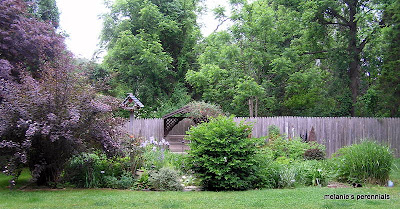 This weekend (and much of the future season) I'll be playing with my succulents. I can't help it, they just call to me.
This weekend (and much of the future season) I'll be playing with my succulents. I can't help it, they just call to me.Earlier this morning I posted on my Melanie's Perennials blog, it too was about succulents and some of the plans I have with them.
 There are so many different varieties of Sempervivum and Sedums. I don't claim to be an expert on them, I'm not even super careful about keeping their names. If I have a name, I put it in the pot. If I don't, I still grow them and love them. Many varieties were sold to me without names. They are as beautiful as the named varieties so I really just don't care.
There are so many different varieties of Sempervivum and Sedums. I don't claim to be an expert on them, I'm not even super careful about keeping their names. If I have a name, I put it in the pot. If I don't, I still grow them and love them. Many varieties were sold to me without names. They are as beautiful as the named varieties so I really just don't care.This one I've had for 4 or 5 years now. It's been divided each and every year and makes these soft little tufts. The name on the pot was TBA, probably just stood for "to be advised".
 One of the reasons I love these plants so much is because they are so forgiving of harsh conditions and so darn easy to grow! This Sedum acre is in a small, cracked plastic pot. It's grown out of the pot and along the ground, rooting in tiny cracks in the concrete.
One of the reasons I love these plants so much is because they are so forgiving of harsh conditions and so darn easy to grow! This Sedum acre is in a small, cracked plastic pot. It's grown out of the pot and along the ground, rooting in tiny cracks in the concrete. Here's the same plant, it just crept it's way along the concrete and wound around a nearby planter. You would never know that there's no soil under here.
Here's the same plant, it just crept it's way along the concrete and wound around a nearby planter. You would never know that there's no soil under here. Every now and then an escapee finds a foothold. This is a tiny Sedum, I'm pretty sure it's name is Sedum dasyphyllum. I have no problem with it having caught hold in the cracks here, in fact I'm going to encourage it to grow!
Every now and then an escapee finds a foothold. This is a tiny Sedum, I'm pretty sure it's name is Sedum dasyphyllum. I have no problem with it having caught hold in the cracks here, in fact I'm going to encourage it to grow! Pots of these babies are for sale, there's not than many potted up yet and each and every one is different. The watering can is not for sale, I just adore it and can't part with it!
Pots of these babies are for sale, there's not than many potted up yet and each and every one is different. The watering can is not for sale, I just adore it and can't part with it! This afternoon friends are coming over with their children. If you do any gardening with kids you have to try these Hens & Chicks. Kids love them! I've done programs at schools and brought in pots of Sempervivum (Hens & chicks). They are so touchable, not thorny or prickly but soft and fuzzy.
This afternoon friends are coming over with their children. If you do any gardening with kids you have to try these Hens & Chicks. Kids love them! I've done programs at schools and brought in pots of Sempervivum (Hens & chicks). They are so touchable, not thorny or prickly but soft and fuzzy.The kids especially love the cobwebbed ones and love the fact that they can take them in their fingers and tease the plants apart. The whole idea of the mother plant (the hen) and her little babies (the chicks) appeals to them.
 Here's a close up shot, these are just about to send out little babies and we'll be making three different pots from this one piece.
Here's a close up shot, these are just about to send out little babies and we'll be making three different pots from this one piece. Here's one that was divided out a week ago. You can see how I left room for it to fatten up and for any babies that pop out to find a place to root.
Here's one that was divided out a week ago. You can see how I left room for it to fatten up and for any babies that pop out to find a place to root. I always add in a few non-succulent plants. This is a Saxifraga 'Cloth of Gold' that I bought yesterday. I haven't had luck with them in the past but this is a new variety for me. It's going to be paired with a beautiful blue foliaged Allium (you can see it in the top photo in the right side of the hypertufa trough).
I always add in a few non-succulent plants. This is a Saxifraga 'Cloth of Gold' that I bought yesterday. I haven't had luck with them in the past but this is a new variety for me. It's going to be paired with a beautiful blue foliaged Allium (you can see it in the top photo in the right side of the hypertufa trough).Off to play,
Melanie










